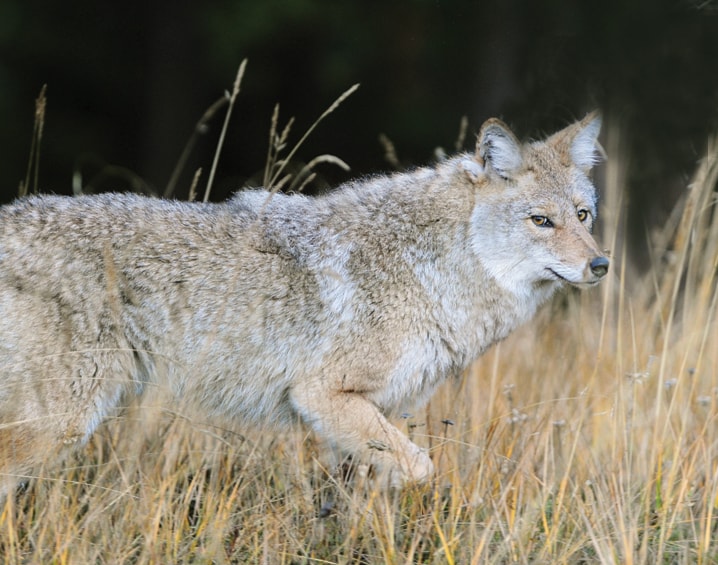She’s a cunning opportunist with a keen eye for body language and a lethal ability to use those observations in her pursuit of a hot lunch.
She and her family are jealously protective of their territory and are more than happy to snack on whatever furry or feathered bundle crosses their path, leaving only their tracks as evidence and celebrating their victories in impromptu concerts that echo through the night.
Alberta Agriculture and Rural Development, in its manual on coyote control, acknowledges the animal’s distinctive chorus as an integral element in Alberta’s wildlife scene.
“The song of the coyote is a sound that evokes a vision of picturesque wilderness and beauty to most people; even those who are recipients of its predation,” its authors write in a study guide aimed at helping farmers protect their herds and flocks.
Coyotes evolved in the Pleistocene Epoch, competing against much larger predators and sometimes becoming prey themselves, says animal behaviourist Valerius Geist, zoology professor emeritus at the University of Calgary.
While the massive beasts that stalked even larger prey relied on size and power, coyotes developed the ability to analyze other animals, seeking signs of weakness or vulnerability and then gobbling them up, says Geist from his home on Vancouver Island.
It’s a crude and agonizing death for coyote prey, which are literally eaten alive.
Like deer and magpies, the wild canines have adapted well to urban environments and, in some cases, have learned to seek human prey.
Until the late 18th Century, coyote populations stayed in check largely through competition with wolves and through the loss of their pups to a variety of other predators, says Geist.
Coyote numbers throughout the Canadian Prairies grew rapidly with the advancement of farming and urbanization. They adapted easily to the human development that led to the eradication of wolves in areas where farmers settled and communities grew, he says.
All the traits that contributed to the coyote’s success have helped it adapt to the inner edges of human populations, including the network of trails and natural lands within the City of Red Deer.
“They’re very smart little animals, but can also be extremely destructive,” says Geist.
There have been no reports in recent years of coyotes attacking humans in Red Deer, says animal control officer Duane Thomas. However, he has heard third-party reports of problems involving family pets, especially smaller dogs.
Coyotes normally avoid people, but are less averse to mixing up with loose dogs, says Thomas.
“That’s why it’s important to keep your dog on a leash,” he says.
A small dog that disappears into the bush and cannot be called back is an easy lunch for a coyote, says Thomas.
In areas where there is heavier competition for normal prey, especially rodents, coyotes will size up other opportunities, says Geist.
Small children can become victims of coyotes that have taken the time to study their behaviour and wait for an opportunity to move in.
“They spend a long time teasing, observing and watching,” he says.
At the beginning, a coyote will sit on its haunches and observe a pet or a child’s behaviour, licking occasionally while learning as much as it can about its target.
As it gains insight, the animal will make tentative approaches, sometimes nipping to test its target’s reactions. It will even engage in play with unsuspecting dogs, waiting for the right moment to make a kill, says Geist.
Coyotes target dogs because they cannot tolerate other canines in their territories, much the same as wolves will not tolerate coyotes, he says.
In the absence of wolves, mange is the only natural check on coyote populations, killing infected animals slowly and painfully, says Geist.
The University of Northern British Columbia describes mange as a contagious mite, passed from animal to animal by direct contact and by contact at shared sites, such as the dens in which they raises their litters.
Severely infected animals die from complications of mange, including exposure resulting from hair loss.
Mange mites tend to catch hold in animals that are less healthy to begin with and then spreads by infesting their dens. Coyotes that would normally move from den to den to avoid contaminants are forced to reuse the same sites in an area that has become too crowded, says Geist.
Good prices for pelts are the best check in areas where there are populations of healthy coyotes, he says.
As long as a few hunters and trappers are taking the best animals, those that remain will be better off through the loss of competition and will then have a positive effect in the local environment, including keeping mice, ground squirrels and other small pests under control.
Coyote families can be tolerated in urban environments, but must be observed closely to sort out any animals that are showing signs of interest in people and pets, says Geist.
People out walking their dogs are not likely to notice the coyotes that are watching them, he says.
“If you walk around in the park, coyotes are watching your dog.”
bkossowan@www.reddeeradvocate.com
